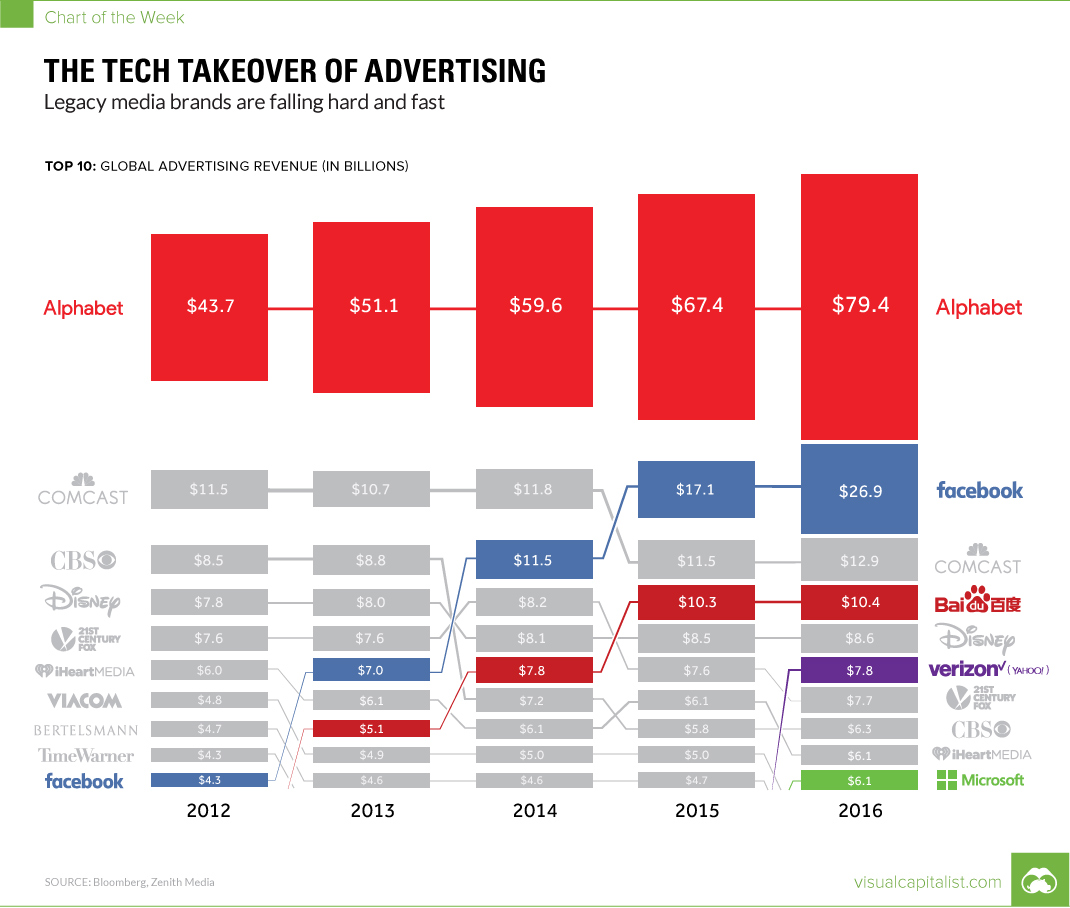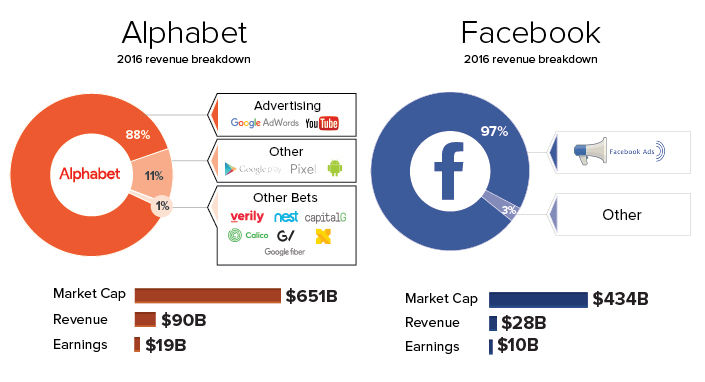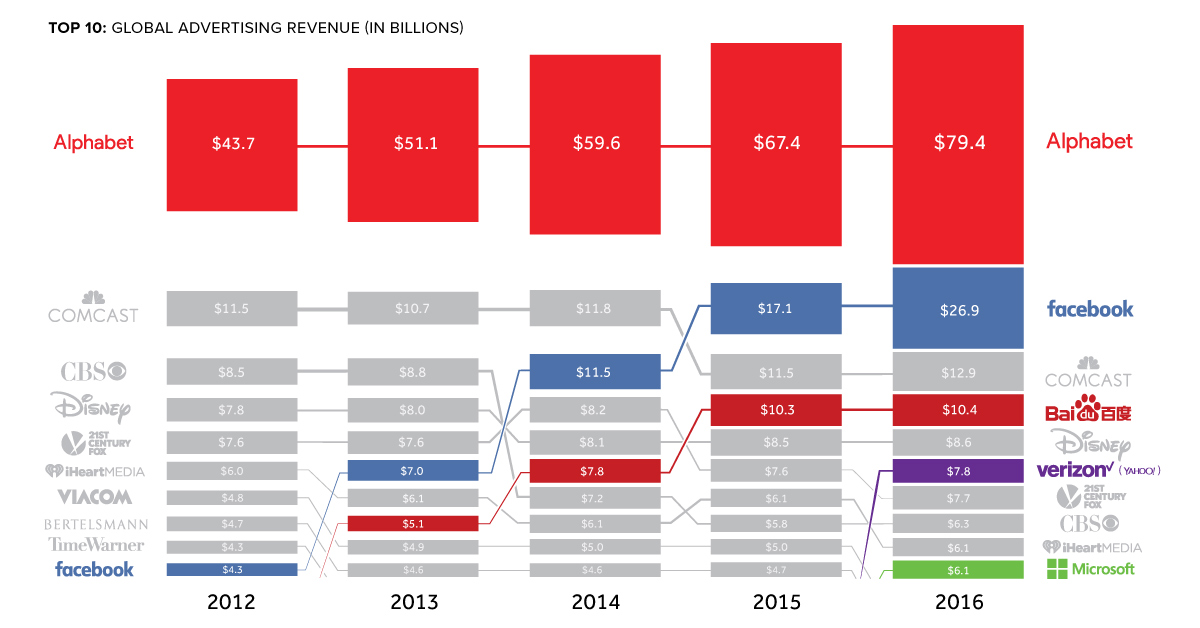Technology
The Tech Takeover of Advertising in One Chart

The Tech Takeover of Advertising in One Chart
The Chart of the Week is a weekly Visual Capitalist feature on Fridays.
Both Alphabet and Facebook have carefully worked at crafting their public images.
Most people see these companies as forward-looking tech companies that are shaping our future through high-flying initiatives like Google X or Oculus VR. They put money into big moonshots that could potentially change the world, and their actions are closely followed by people in and outside of the technology sector.
But, despite these other initiatives and some diligent messaging, make no mistake – both Alphabet and Facebook are media companies that get their money from one source.
Advertising makes up the vast majority of their business, and they’ve both become very good at it.
True Ad Dominance
Earlier this year, we put together a chart that broke down the revenues of the large tech companies:
Facebook earns 97% of its revenue from ads. Meanwhile, Alphabet earns 88% from ads, while getting less than 1% of its revenue from moonshots (at least for now).
Alphabet and Facebook are so good at advertising, in fact, that traditional media can’t keep up – and as a result, companies like CBS, 21st Century Fox, and iHeartMedia are now fighting for scraps.
Three is a Crowd
It’s not just Alphabet and Facebook that have unlocked the secret to ad dominance. They were just the fastest to do so.
China’s search engine giant, Baidu, is quickly climbing the ranks as well. Even though growth slowed in 2016 due to changes in China’s ad rules, the company will eventually be the third-largest media giant in the world. If Baidu can bump ad revenues by another 20%, it’ll move past Comcast, which owns brands like NBCUniversal and Telemundo.
Microsoft is also making its presence felt, debuting in the Top 10 for the first time in 2016. Microsoft’s Bing search network is now in 36 countries, while making up 33% of the U.S. PC search market. On top of that, the company also acquired LinkedIn, which now contributes $1 billion in revenue to the coffers.
The sea change is still in process – but in a couple years, there may not be a single traditional media that makes the top five list for global ad revenues. The tech takeover continues.
Technology
All of the Grants Given by the U.S. CHIPS Act
Intel, TSMC, and more have received billions in subsidies from the U.S. CHIPS Act in 2024.

All of the Grants Given by the U.S. CHIPS Act
This was originally posted on our Voronoi app. Download the app for free on iOS or Android and discover incredible data-driven charts from a variety of trusted sources.
This visualization shows which companies are receiving grants from the U.S. CHIPS Act, as of April 25, 2024. The CHIPS Act is a federal statute signed into law by President Joe Biden that authorizes $280 billion in new funding to boost domestic research and manufacturing of semiconductors.
The grant amounts visualized in this graphic are intended to accelerate the production of semiconductor fabrication plants (fabs) across the United States.
Data and Company Highlights
The figures we used to create this graphic were collected from a variety of public news sources. The Semiconductor Industry Association (SIA) also maintains a tracker for CHIPS Act recipients, though at the time of writing it does not have the latest details for Micron.
| Company | Federal Grant Amount | Anticipated Investment From Company |
|---|---|---|
| 🇺🇸 Intel | $8,500,000,000 | $100,000,000,000 |
| 🇹🇼 TSMC | $6,600,000,000 | $65,000,000,000 |
| 🇰🇷 Samsung | $6,400,000,000 | $45,000,000,000 |
| 🇺🇸 Micron | $6,100,000,000 | $50,000,000,000 |
| 🇺🇸 GlobalFoundries | $1,500,000,000 | $12,000,000,000 |
| 🇺🇸 Microchip | $162,000,000 | N/A |
| 🇬🇧 BAE Systems | $35,000,000 | N/A |
BAE Systems was not included in the graphic due to size limitations
Intel’s Massive Plans
Intel is receiving the largest share of the pie, with $8.5 billion in grants (plus an additional $11 billion in government loans). This grant accounts for 22% of the CHIPS Act’s total subsidies for chip production.
From Intel’s side, the company is expected to invest $100 billion to construct new fabs in Arizona and Ohio, while modernizing and/or expanding existing fabs in Oregon and New Mexico. Intel could also claim another $25 billion in credits through the U.S. Treasury Department’s Investment Tax Credit.
TSMC Expands its U.S. Presence
TSMC, the world’s largest semiconductor foundry company, is receiving a hefty $6.6 billion to construct a new chip plant with three fabs in Arizona. The Taiwanese chipmaker is expected to invest $65 billion into the project.
The plant’s first fab will be up and running in the first half of 2025, leveraging 4 nm (nanometer) technology. According to TrendForce, the other fabs will produce chips on more advanced 3 nm and 2 nm processes.
The Latest Grant Goes to Micron
Micron, the only U.S.-based manufacturer of memory chips, is set to receive $6.1 billion in grants to support its plans of investing $50 billion through 2030. This investment will be used to construct new fabs in Idaho and New York.
-

 Education1 week ago
Education1 week agoHow Hard Is It to Get Into an Ivy League School?
-

 Technology2 weeks ago
Technology2 weeks agoRanked: Semiconductor Companies by Industry Revenue Share
-

 Markets2 weeks ago
Markets2 weeks agoRanked: The World’s Top Flight Routes, by Revenue
-

 Demographics2 weeks ago
Demographics2 weeks agoPopulation Projections: The World’s 6 Largest Countries in 2075
-

 Markets2 weeks ago
Markets2 weeks agoThe Top 10 States by Real GDP Growth in 2023
-

 Demographics2 weeks ago
Demographics2 weeks agoThe Smallest Gender Wage Gaps in OECD Countries
-

 Economy2 weeks ago
Economy2 weeks agoWhere U.S. Inflation Hit the Hardest in March 2024
-

 Green2 weeks ago
Green2 weeks agoTop Countries By Forest Growth Since 2001
















